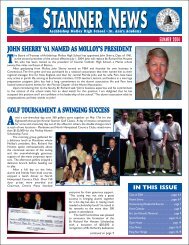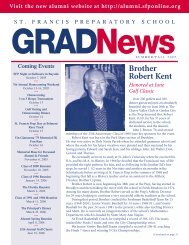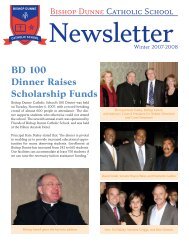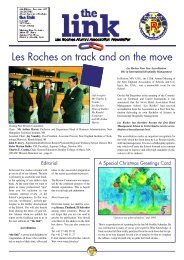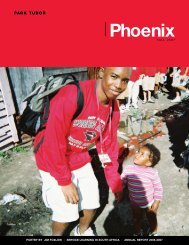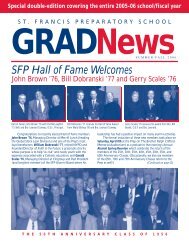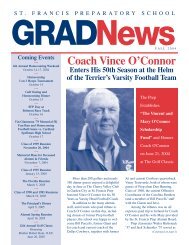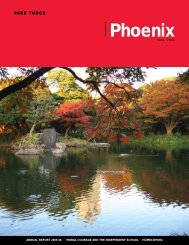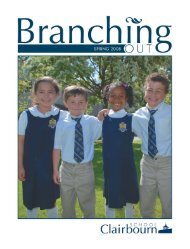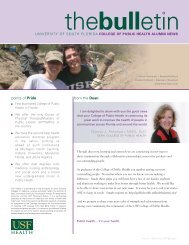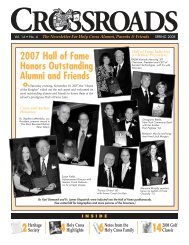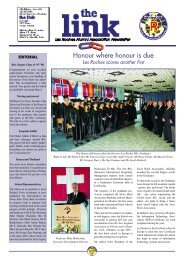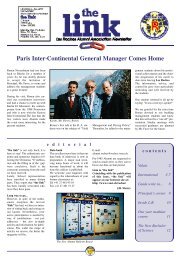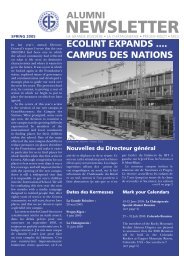Phoenix
Phoenix
Phoenix
Create successful ePaper yourself
Turn your PDF publications into a flip-book with our unique Google optimized e-Paper software.
NEWS OF THE SCHOOL<br />
Smith College begins partnership with Park Tudor<br />
Throughout the world, only<br />
172 students have had the<br />
opportunity to analyze a segment<br />
of their DNA to determine<br />
if they carry a certain “taster”<br />
gene – and 140 of them are<br />
Park Tudor biology students!<br />
Thanks to a generous grant<br />
from Park Tudor alumnus<br />
Dob Bennett ’76 and his wife<br />
Deborah, students in Upper<br />
School biology and AP biology<br />
classes had the unique<br />
opportunity in January to participate<br />
in sophisticated DNA<br />
experiments led by four Smith<br />
College professors. The professors’<br />
visit was the first in a<br />
planned annual collaboration<br />
with Smith College faculty to<br />
work with students in a variety<br />
of disciplines.<br />
Drs. Bob Merritt, Steve<br />
Williams, Sandra Laney and<br />
Lori Saunders from the Smith<br />
College Biological Sciences<br />
Department spent the week of<br />
January 22-27 leading students<br />
in two projects related to genetics<br />
and DNA. The professors<br />
are involved in the Smith Summer<br />
Science and Engineering<br />
Program and an annual Molecular<br />
Biology “Boot Camp” for<br />
elite scientists from corporate<br />
and molecular research centers<br />
around the world.<br />
Upper School Director Jill<br />
Kaechele coordinated the overall<br />
project with Park Tudor<br />
Science Department Chair<br />
Steve Math and faculty members<br />
Justin Dammeier, Mark<br />
Dewart and Scott McDougall.<br />
In one experiment, students<br />
tasted a piece of paper infused<br />
with phenylthiocarbamide<br />
(PTC) to see if they could<br />
taste the bitter, burned taste<br />
of the chemical – a common<br />
lab done with Middle School<br />
science students. (Only about<br />
70% of the population has the<br />
ability to taste PTC – the other<br />
30% does not carry the tasting<br />
gene.) What made this experiment<br />
special, however, is that<br />
the Smith College professors<br />
then taught the students how<br />
to swab their cheek for a DNA<br />
sample and analyze the results<br />
to determine the genotype to<br />
which they belong.<br />
“This genetics laboratory...requires<br />
students to use<br />
not only their knowledge of<br />
molecular techniques in genetics<br />
but also their knowledge<br />
of Mendelian genetics, population<br />
genetics, probability,<br />
and pedigree analysis...and in<br />
determining their PTC phenotype<br />
and genotype, students<br />
are learning something themselves,”<br />
write the professors.<br />
Students said they found<br />
the subject matter challenging,<br />
adding that it gave them a<br />
preview of what their college<br />
studies would be like.<br />
Rosalind Kelcourse ’10<br />
wrote, “Not only did I discover<br />
a great amount about the<br />
myriad of opportunities open<br />
to me, I also was inspired<br />
to begin studying philosophy.<br />
And yes, there is a connection<br />
between little bits of DNA<br />
resting peacefully in a well and<br />
‘life’s big questions.’ I plan on<br />
pursuing my newfound fascination<br />
until my breath is taken<br />
away. I am proud to be one of<br />
the few people in the world<br />
who knows their genotype.”<br />
Students also learned more<br />
about genetics by participating<br />
in a mock crime scene<br />
investigation, determining<br />
who committed a “murder”<br />
by conducting DNA testing of<br />
a blood sample found at the<br />
“crime scene.” The processes<br />
remained confidential, with<br />
only the individual students<br />
having access to their personal<br />
DNA results.<br />
In addition to the classroom<br />
work, the Smith College professors<br />
met with young women<br />
in the freshman, sophomore<br />
and junior classes to provide<br />
them with information about<br />
summer course and program<br />
Smith College professor Dr. Bob Merritt shows AP biology student Alexander<br />
Zience ’08 how to set up an experiment to identify a segment of DNA.<br />
offerings at Smith College,<br />
including possible financial<br />
aid.<br />
Freshman Miranda Voege<br />
said, “This [program] showed<br />
me that not only can men be<br />
established people in the science<br />
world. Women can be<br />
just as established. Men aren’t<br />
necessarily better at math and<br />
science.”<br />
During the professors’<br />
visit, the Smith College Club<br />
of Indianapolis (of which the<br />
treasurer is Park Tudor parent<br />
Wendy Ponader ’78) hosted a<br />
tea for the professors, alumni<br />
and prospective students. Park<br />
Tudor sponsored a reception<br />
for the Smith faculty, Indianapolis-based<br />
scientists from<br />
Eli Lilly and Company and<br />
other laboratories, participating<br />
faculty and AP Biology<br />
students to begin the groundwork<br />
for possible program<br />
linkages for our students and<br />
faculty in the sciences such<br />
as internships, summer programs,<br />
equipment, grants and<br />
independent study. Park Tudor<br />
parents Jim Thomas and Kathy<br />
and Dan Hasler helped coordinate<br />
the meeting.<br />
Tentative plans for the 2007-<br />
08 school year call for a focus<br />
on the arts, with visiting Smith<br />
College fine arts professors<br />
working with students.<br />
The Smith College program<br />
is a component of Park Tudor’s<br />
strategic management plan,<br />
“PT 2010,” which calls for<br />
the school to host guest lecturers<br />
and visiting scholars who<br />
represent a variety of cultural<br />
perspectives and interests.<br />
SPRING 2007 PARK TUDOR PHOENIX 5



